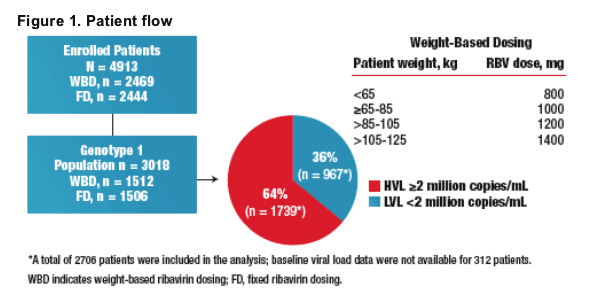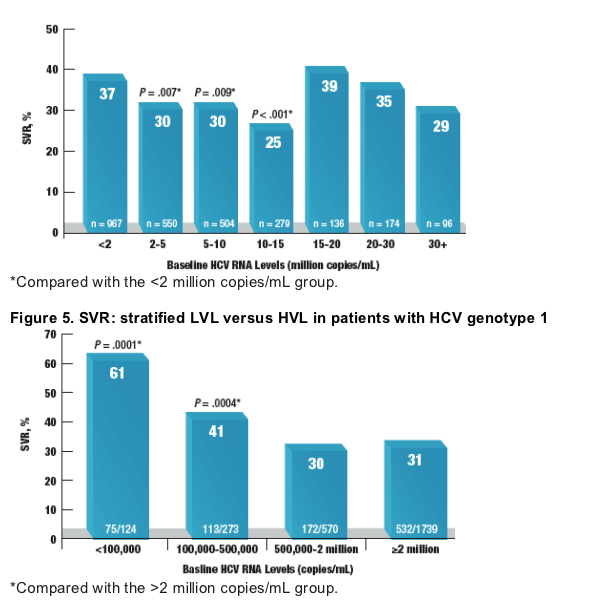 |
 |
 |
| |
Affect of Viral Load on SVR Rates to PegIntron/RBV in Genotype 1 Patients in WIN-R Study
|
| |
| |
"Stratification of Viral Load in Patients With Genotype 1 HCV: Impact on Sustained Virologic Response in the WIN-R Trial"
Reported by Jules Levin
DDW, May 2006, Los Angeles
Ira M. Jacobson,1 Robert S. Brown,2 Furqaan Ahmed,1 Bradley Freilich,3 Nezam Afdhal,4 Paul Kwo,5 John Santoro,6 Scott Becker,7 Adil Wakil,8 David Pound,9 Louis H. Griffel,10 Clifford A. Brass,10 for the WIN-R Study Group
1Weill Medical College of Cornell University; 2Columbia University College of Physicians & Surgeons New York, New York; 3Baptist Medical Center, Kansas City, Missouri; 4Beth Israel Deaconess Medical Center, Boston, Massachusetts; 5Indiana University School of Medicine, Indianapolis, Indiana;
6Atlantic Gastroenterology Associates, Egg Harbor Township, New Jersey; 7Austin Gastroenterology, Austin, Texas; 8California Pacific Medical Center, San Francisco, California; 9Indianapolis Gastroenterology RSCH, Indianapolis, Indiana; 10Schering-Plough Research Institute, Kenilworth, New Jersey
ABSTRACT
Background: Pretreatment hepatitis C (HCV) viral levels have been associated with the likelihood of achieving a sustained virologic response (SVR) during the course of antiviral therapy with pegylated interferon and ribavirin (RBV).
Aim: To assess the relationship of pretreatment HCV viral load with SVR rates in patients with genotype 1 using data from the WIN-R Trial, the largest HCV therapeutic trial to date.
Methods: Patients in a community setting with chronic hepatitis C were randomized to Peg IFN alfa-2b 1.5 _g/kg once weekly plus RBV 800 mg/day or RBV based on weight: <65 kg-800 mg/day, 65 to 85 kg-1000 mg/day, >85 to 105 kg-1200 mg/day, and >105-125 kg-1400 mg/day. Treatment was 48 weeks for patients with HCV genotype 1. Follow-up for all patients was 24 weeks. HCV RNA was determined by PCR (Taqman/SPRI) at weeks 24, 48, and 72. SVR rates were analyzed according to baseline HCV viral loads in patients with genotype 1. Low viral load at baseline was defined as <2 million copies/ml; high viral load was defined as >2 million copies/ml.
Results: 225 sites enrolled 4913 patients (2444 FD and 2469 WBD) who received at least one dose of drug. Intention-to-treat analysis showed a significant improvement (p=0.04) in SVR with WBD (1,111/2,469 = 45%)
compared to FD (1,029/2,444 = 42%). 3018 patients had genotype 1 with an overall SVR rate of 33% (984/3018).
In patients with genotype 1, SVR rates were significantly higher (p = 0.004) in patients with a low HCV viral load (37%, 358/967) than in those with a high viral load (31%, 532/1739). SVR rates in patients with viral load <2 million copies/ml were compared with patients with viral loads >/= 2 million copies/ml.
Reductions in SVR were noted in more patient groups with baseline HCV RNA levels of 2-15 million copies/ml than in patients with >15 million copies/ml.
Conclusion: Within the genotype 1 patient population with high viral load as defined traditionally (> 2 million copies/ml), those with very high viral loads do not have impaired rates of SVR.
Abstract was updated from submitted version.
Background
- Pretreatment hepatitis C virus (HCV) viral load is thought to influence the likelihood of achieving a sustained virologic response (SVR) during antiviral therapy with pegylated interferon (PEG-IFN) and ribavirin (RBV)
- Two million copies/mL has traditionally been considered the cutoff for high viral load (HVL)
Aim
- To assess the relationship of pretreatment HCV viral load with SVR rates in patients with HCV genotype 1 using data from the WIN-R Trial, the largest HCV therapeutic trial to date
Methods
- Patients with chronic hepatitis C in academic and community settings throughout the United States were randomized to PEG-IFN alfa-2b (PegIntron®) 1.5
_g/kg/week plus RBV 800 mg/day or RBV based on weight (Figure 1)
- Treatment was 48 weeks for patients with HCV genotype 1; follow-up was 24 weeks
- HCV RNA levels were measured with polymerase chain reaction (Taqman; Schering-Plough Research Institute; lower limit of detectability was 100 copies/mL, which is equilavant to 29 IU/mL) at weeks 24, 48, and 72
- This study was designed before adoption of the International Units system. Therefore, results are reported in copies/mL
- SVR rates were analyzed according to baseline HCV viral loads in patients with genotype 1
- Low viral load (LVL) was defined as <2 million copies/mL
- HVL was defined as >2 million copies/mL
- A total of 4913 patients were enrolled in the WIN-R trial at 225 sites, received at least 1 dose of drug, and were included in the primary safety analysis
- A total of 2444 patients were randomized to RBV fixed dosing (FD)
- A total of 2469 patients were randomized to RBV weight-based dosing (WBD)
RESULTS
Patients
- Of the 4913 patients enrolled in the WIN-R trial, 3018 had HCV genotype 1 and were included in this analysis (Figure 1)
- Mean age was 46 years for the study population; mean weight was 84.3 kg

Primary Efficacy Analysis
- The primary efficacy analysis in the WIN-R trial was SVR rates in patients weighing >/= 65 kg
- In patients weighing >/= 65 kg with gentotype 1, significantly more patients in the WBD group achieved SVR than in the FD group (Figure 2)
- However, when analyzed by viral load, there was a significant difference only for those patients in the HVL group (WBD, 32% vs FD, 27%; P = .047)
Figure 2. Genotype 1 patients in WIN-R (primary efficacy analysis, >/= 65 kg)


Author Summary
- In genotype 1 patients, WBD of ribavirin results in significantly greater SVR rates than FD
- Among patients with genotype 1 HVL, SVR rates do not appear to deteriorate with incremental increases in HCV viral load
- In this study, the highest SVR rates occurred in patients with HCV viral loads of <500,000 copies/mL
Author Conclusions
- Unexpectedly, patients with HCV genotype 1 and HVL do not have progressively lower SVR as viral load increases
- Very high viral levels in patients with HCV genotype 1 should not discourage attempts at viral eradication
- Further studies are needed to reevaluate the current cutoff of 2 million copies/mL used to differentiate patients with low and high HCV viral loads
|
| |
|
 |
 |
|
|